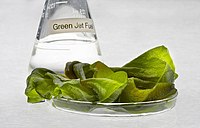
Wastewater treatment using filamentous algae - A review.
Sign Up to like & getrecommendations! Published in 2019 at "Bioresource technology"
DOI: 10.1016/j.biortech.2019.122556
Abstract: Wastewater treatment using algae is a promising approach for efficient removal of contaminating nutrients and their conversion into useful products. Monocultures of filamentous algae provide easier harvesting compared to microalgae, and better control of biomass… read more here.
Keywords: filamentous algae; treatment using; wastewater treatment; using filamentous ... See more keywords

Physiological differences between free-floating and periphytic filamentous algae, and specific submerged macrophytes induce proliferation of filamentous algae: A novel implication for lake restoration.
Sign Up to like & getrecommendations! Published in 2019 at "Chemosphere"
DOI: 10.1016/j.chemosphere.2019.124702
Abstract: Restoration of submerged macrophytes is widely applied to counteract eutrophication in shallow lakes. However, proliferation and accumulation of filamentous algae (possessing free-floating and periphytic life forms) hamper growth of submerged macrophytes. Here, we explored factors… read more here.
Keywords: algae; free floating; filamentous algae; restoration ... See more keywords

Effect of a nitrogen pulse on ecosystem N processing at different temperatures: A mesocosm experiment with 15NO3− addition
Sign Up to like & getrecommendations! Published in 2017 at "Freshwater Biology"
DOI: 10.1111/fwb.12940
Abstract: Shallow lakes may play an important role for the nitrogen (N) balance in drainage basins by processing, transferring and retaining N inputs. An increase in the frequency of storm-induced short-term N pulses and increased water… read more here.
Keywords: addition; pulse; filamentous algae; macrophytes filamentous ... See more keywords

Investigating the use of aquatic weeds as biopesticides towards promoting sustainable agriculture
Sign Up to like & getrecommendations! Published in 2020 at "PLoS ONE"
DOI: 10.1371/journal.pone.0237258
Abstract: Aquatic weeds such as muskgrass (Chara spp.), water hyacinth (Eichhornia crassipes), water lettuce (Pistia stratiotes), hydrilla (Hydrilla verticillate), filamentous algae (Lyngbya wollei), and duckweed (Lemna minor) thrive in farm canals within the Everglades Agricultural Area… read more here.
Keywords: aquatic weeds; water; filamentous algae; investigating use ... See more keywords